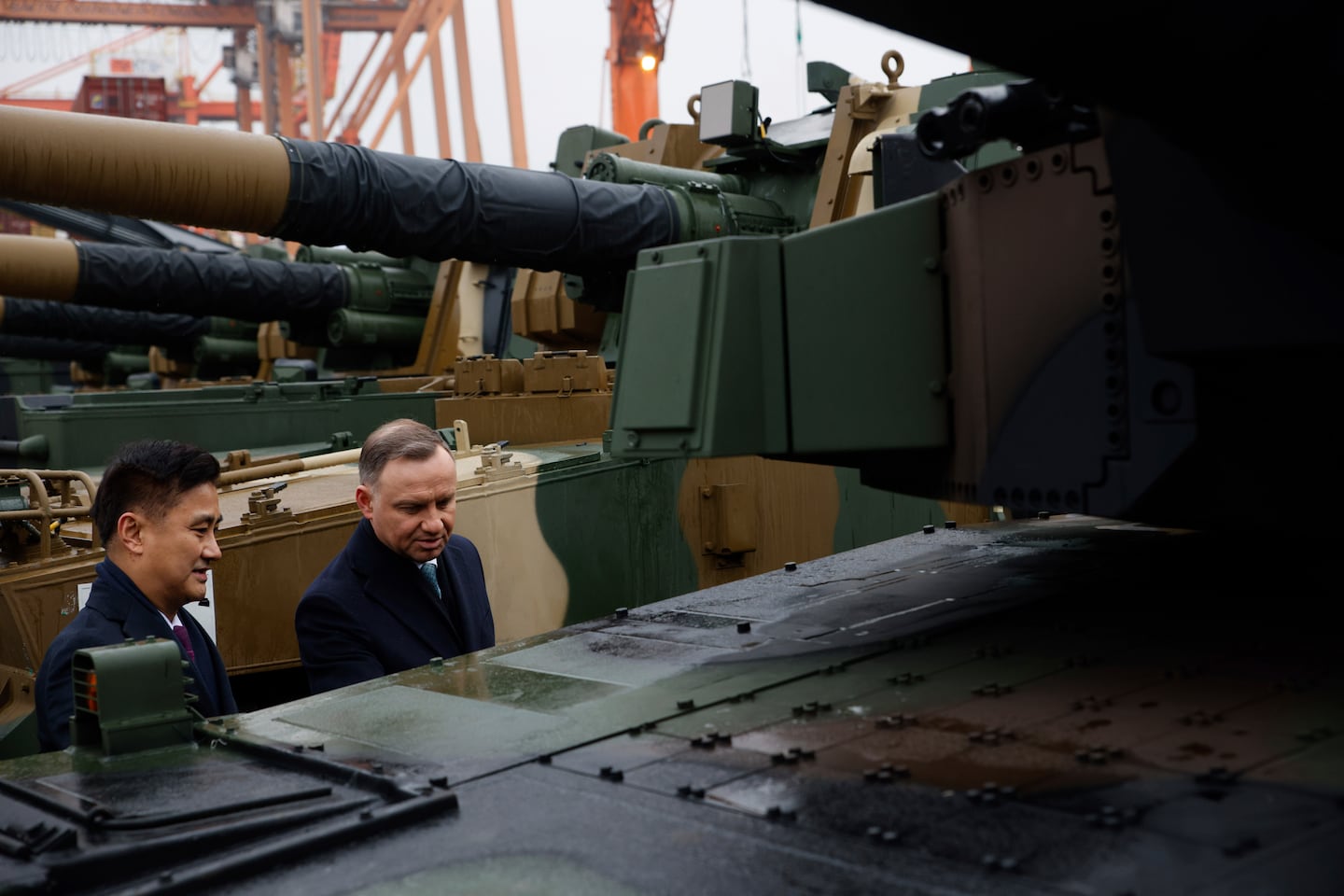South Korea is increasingly favored as an affordable provider to nations seeking to refill stockpiles depleted of Soviet-era weapons. The country’s arms exports this year topped $17 billion in November, far surpassing a record $7.25 billion last year. Of those sales, the deal with Poland accounted for $12.4 billion, followed by a $1.7 billion deal with Egypt.
The South Korean minister of arms procurement, Eom Dong-hwan, said the “world is watching with attention” the budding defense cooperation between his country and Poland. The Polish government purchased nearly 1,000 K2 tanks, dozens of FA-50 jets, hundreds of K9 howitzers and Chunmoo multiple rocket launchers, and Eom voiced hope that the equipment will contribute to the nation’s deterrence at a time of “rapid changes in the security situation.”
South Korea’s defense industry has its origins in Cold War-era hostilities with rival North Korea in the mid-1940s. The South, initially armed by U.S. forces to fight the Soviet-backed North during the Korean War, was pursuing its own weapons systems as the United States reduced its military presence in the early 1990s. The threat of conflict with the North remains a prime industry focus today.
“As a country that technically remains in a state of war, South Korea has a distinctive capability for mass production of arms that can be promptly deployed in actual warfare,” said Choi Gi-il, a military expert at Sangji University in South Korea. Government support has given the industry a “decisive competitive edge,” with the global arms market taking note of the weapons’ performance as well as their cost-effectiveness, according to Choi.
“This past year in Ukraine was sort of a coming-out party, this public unveiling of what was very well underway [in Korea] and underappreciated publicly. But it’s not just Poland. They’re winning in the Middle East. They’re winning in Southeast Asia,” said Rexon Ryu, the president of the Asia Group in Washington who served as chief of staff to U.S. Defense Secretary Chuck Hagel in the Obama administration.
South Korean President Yoon Suk Yeol announced in August that the country aims to rise four spots in the rankings to become the world’s fourth-largest arms exporter by 2027. As part of the plan, Seoul this month unveiled a funding package of $770 million to support investment and research. Yoon and his defense officials said Australia, Norway and other countries are looking to work with South Korean weapon producers.
South Korean defense companies often say they want to become the “Hyundai of defense exports,” a reference to the South Korean automaker that initially filled a niche by making affordable sedans to compete with giants such as Toyota and Ford. Hyundai is today a top global automaker, including of electric vehicles.
The country’s defense industry aspires to coordinate with and sell to the United States. Some U.S. defense companies are watching closely to see where South Korea may become competitive with American firms — particularly if, as Biden administration officials foresee, future needs mean seeking solutions outside of the strapped domestic defense industry.
Bill LaPlante, undersecretary of defense for acquisition and sustainment, told a crowd of lawmakers, analysts and military officers at the Reagan National Defense Forum this month that he now meets regularly with counterparts from allies and partners to discuss more weapons “co-production” and “co-development” because of the Ukraine war.
“There is this recognition that we are all going to need to do this together,” LaPlante said. “We’re going to have to be comfortable using equipment developed in another country in our own military, and vice versa.”
South Korean defense companies’ far-reaching sales pitch has not targeted Ukraine as a potential direct consumer. Wary of its bilateral relations with Moscow, the Yoon government has said it will not send lethal weapons to Ukraine despite Kyiv’s repeated requests.
“The benefits [of that position] are much, much bigger” than the risks of angering Russian President Vladimir Putin, noted Go Myong-hyun, a research fellow at the Asan Institute for Policy Studies in Seoul.
Still, Korean weapons are making their way into Ukraine via other countries. South Korea is poised to send the United States 155mm howitzer shells that will be destined for Ukraine under a confidential deal the Wall Street Journal disclosed last month. The South Korean Defense Ministry said discussions were underway “on the understanding that the U.S. would be the end user.”
A senior U.S. defense official said the structure of the American ammunition deal — the United States is already shipping the Ukrainians thousands of rounds of artillery shells every month — helps Seoul deal with both internal politics and diplomatic relations.
“It’s extraordinarily touchy for the South Koreans to donate ammo to Ukraine,” the official said, speaking on the condition of anonymity because of the sensitivity of the issue.
A Pentagon spokesman, Army Lt. Col. Martin Meiners, acknowledged the U.S. government’s discussions about potential ammunition purchases from South Korea’s defense industry. Meiners said the Pentagon does not disclose specific numbers or schedules involving ammunition production or capacity.
Meanwhile, the Biden administration has accused North Korea of helping to arm the Russian military and then trying to cover up its actions. North Korea has provided infantry rockets and missiles directly to Russia’s Wagner mercenary group, White House national security spokesman John Kirby told reporters on Thursday.
South Korea’s growing defense industry and the fighting in Ukraine have been an economic boon to some manufacturing towns. South Gyeongsang Province, facing “rust belt” concerns as its once-powerful manufacturing sector declined, is among the areas gearing up to recapture past glory.
A recent editorial in the newspaper Kyungnam Shinmun said the province’s defense industry “has been given wings” by the latest surge in business: “As the Russia-Ukraine war prolongs, our defense industry has gained standing as a fruitful one for South Korea’s exports.”
Lee reported from Tokyo and Lamothe from Washington.



